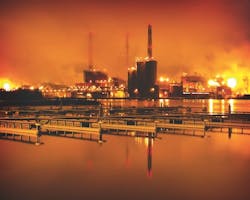Progressive Pulp Processes
About the author: Nick Nicholas is technical sales manager for Genesis Water Technologies. Nicholas can be reached at [email protected].
The pulp and paper industry is one of the largest industrial consumers of water resources within the U.S. and global economies. In the U.S., pulp and paper industry operations require, on average, 14,000 to 16,000 gal of water per metric ton of finished paper product.
According to the Food and Agriculture Organization of the United Nations Secretariat, paper mill operations globally use up to 53,000 gal of water per metric ton of finished paper product because water is used in virtually every stage of the pulp and paper manufacturing process.
Longevity & Sustainability
Paper mills produce significant wastewater and residual sludge waste, necessitating careful consideration about wastewater treatment and discharge, as well as sludge disposal.
Several contaminants integral to pulp and paper waste streams include suspended solids and sediment, absorbable organic halides/chlorinated organic compounds, chemical oxygen demand (COD), biological oxygen demand (BOD), color and bacteria, to name a few.
Due to these issues, focus has been directed toward advanced treatment technologies to handle these requirements and new ways to optimize water resource management through water reuse. These solutions specifically are provided for pulp and paper manufacturers to assist in harnessing wastewater resources in a sustainable way.
Recently, increased focus has been given to the optimized efficiency of paper mills and to the environmental sustainability footprint of the industry. Therefore, water resource management has become a more critical factor facing the industry to save on operating and maintenance costs, address water resource shortages, and comply with environmental regulations.
According to experts in the pulp and paper industry, it is estimated that 80% to 85% of water used in the papermaking process is used as process water. This creates sizable quantities of contaminated water that require the use of onsite wastewater treatment solutions. Treatment options include primary treatment such as clarification to remove large solids and particles, and secondary processes including electrocoagulation water treatment or biological treatment processes in some cases.
Pressure to Progress
Continued pressure within this industry—coupled with regulations and sustainability efforts to improve water savings—has opened opportunities for advanced tertiary treatment.
Tertiary treatment process technologies—such as reverse osmosis (RO) desalination, UV disinfection, advanced oxidation, granular activated carbon and modified clay mediums—are being employed to further treat effluent water to higher qualities. This higher quality water can be reused within the paper operations or externally for cooling water, irrigation or other non-potable applications, which enables fresh water resources to be utilized for other purposes.
Reusing water in a paper mill can be beneficial to the operations of a paper company. Adding or reconfiguring wastewater treatment systems for water reuse enables a facility to recycle a water resource that would have otherwise been disposed. This treatment approach requires pulp and paper companies to engage with companies that have a specific understanding of these processes, chemistry and water quality conditions, not only in the paper industry, but also of that particular paper mill.
Over time, conventional treatment technologies for treating raw water will be replaced with advanced water treatment solutions, including specialized electrocoagulation, advanced oxidation and RO membrane systems. These systems will decrease water loss and provide reliable high-quality water that is virtually free of mineral contaminants, suspended solids, organic compounds, colloids and bacteria, despite variations in source water quality. Using these methods in combination with water reuse strategies can significantly reduce the environment impact of the water consumption by this industry into the future.
Reuse Resolution
A mid-size pulp and paper company producing tissues and paper towels wanted to reuse its washing wastewater to reduce the cost of water usage and maintain environment compliance. The levels of BOD (1,689 mg/L), COD (2,646 mg/L), total suspended solids (TSS) (205 mg/L) and turbidity (80 to 120 ntu) required reduction for reuse.
Genesis Water Technologies provided process consulting/design in addition to building and supplying the pilot system in association with a local partner. The system included specialized screen filtration and electrocoagulation, followed by dissolved air flotation without chemical polymer introduction, and post-polishing filtration. This was accomplished via a continuous process.
The optimal removal percentage efficiency results were:
- Treated BOD levels: 90% reduction;
- Treated COD levels: 84% reduction;
- Treated Turbidity: 92% reduction;
- TSS: 99% reduction; and
- Power consumption of specialized electrocoagulation system: 0.62 to 1.16 kW/cu m (264 U.S. gal of treated water).
The sludge production was minimized with a higher solids content that was easy to dewater, therefore reducing associated disposal costs.
The system has operated successfully within the water quality parameters set by the client to allow reuse of its wash water in the production of its paper products. This water can also be used for its cooling towers or other non-potable applications onsite.
